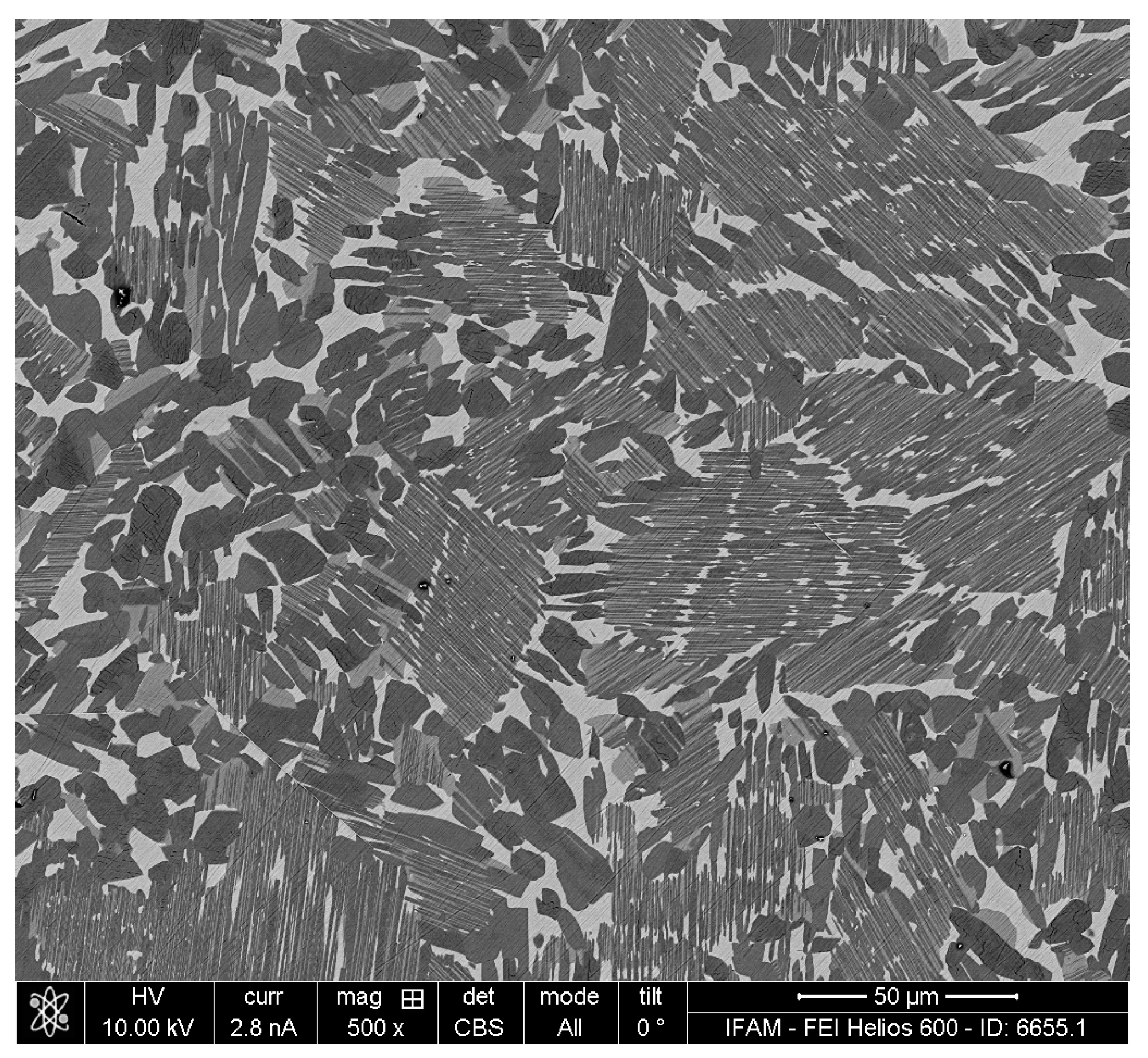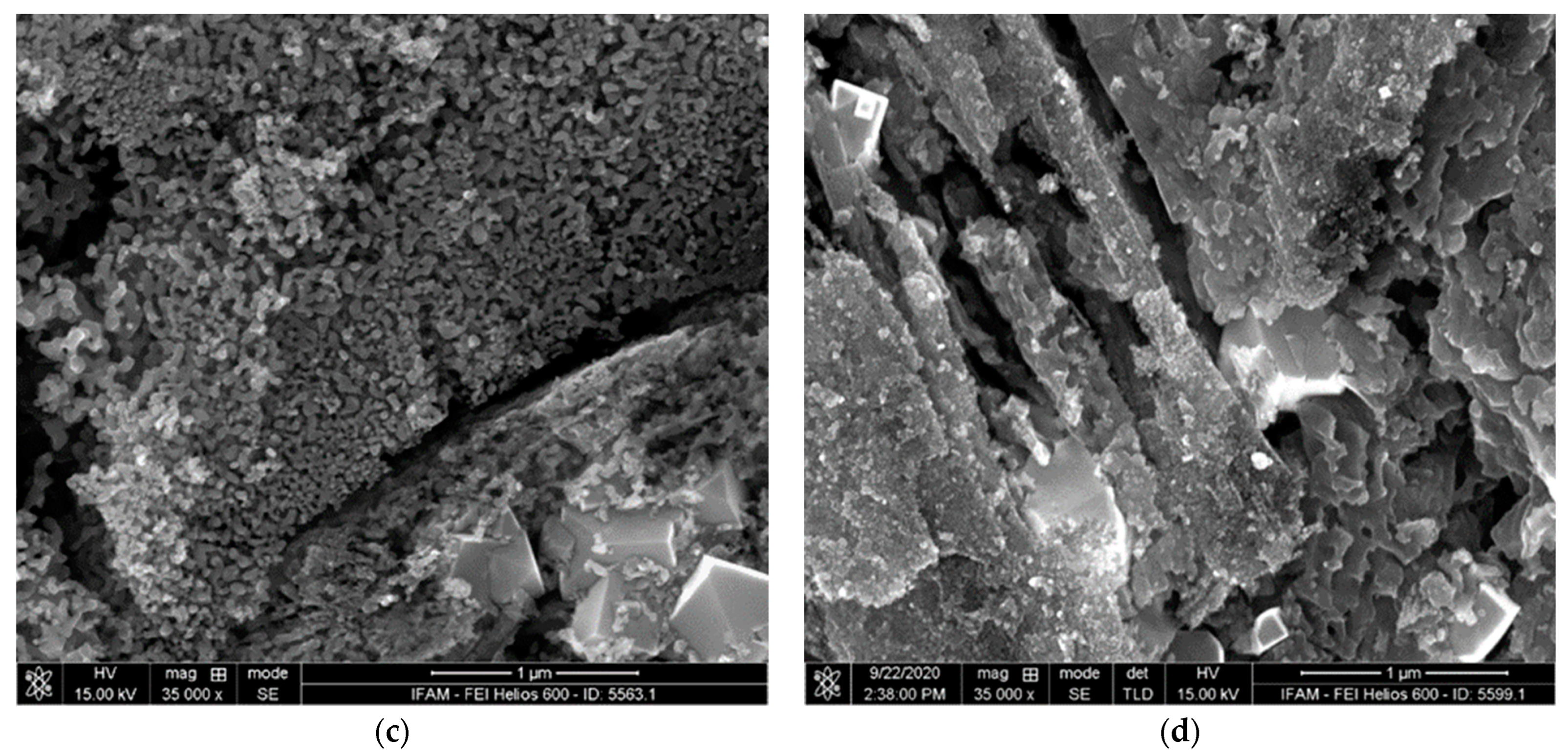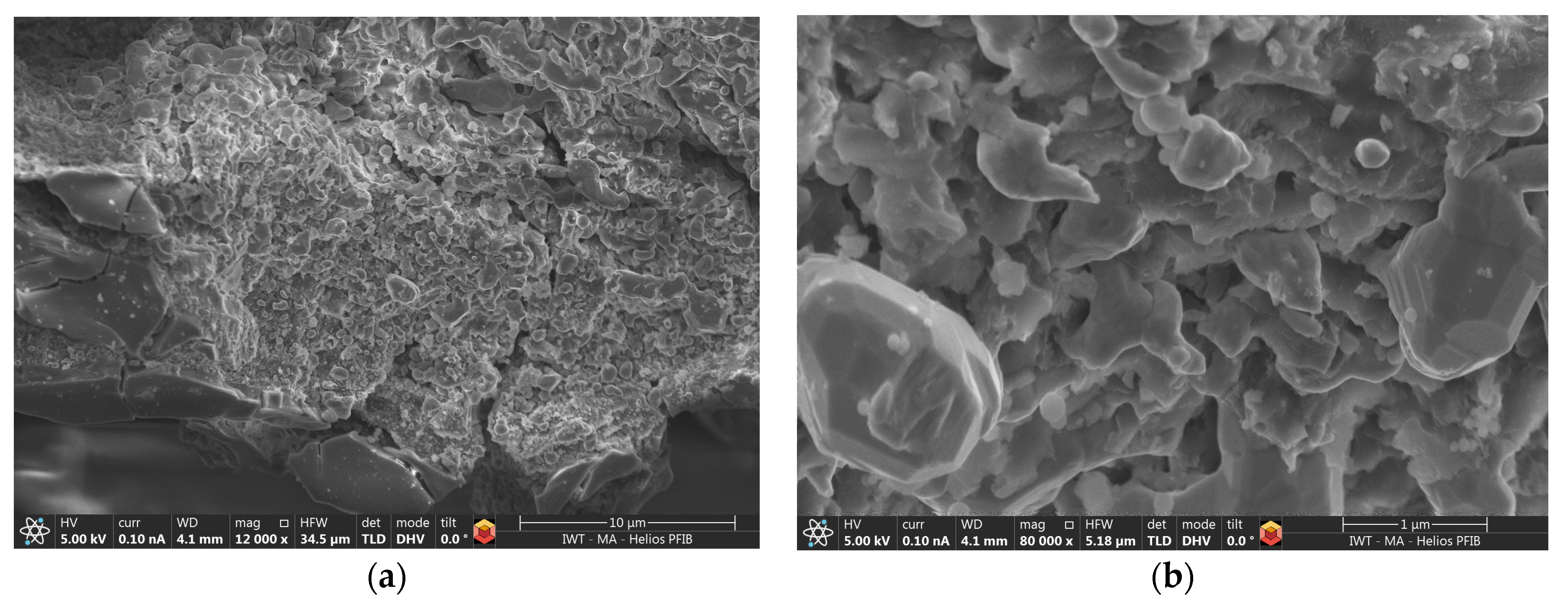Feasibility Study on the Generation of Nanoporous Metal Structures by Means of Selective Alloy Depletion in Halogen-Rich Atmospheres
Abstract
1. Introduction
- The precursor substrate must consist of two groups of components: the components remaining in the structure after the dealloying and the components which shall be removed from and depleted in the precursor. For the latter, it is indispensable that they form volatile halogen compounds. In contrast, for the first group, it is advantageous if no such volatile compounds are formed. Generally, the affinity of the first group to the halogen activator should be low to prevent bonding of the activator which would then be lacking for the transport process.
- None of the components should form poisonous or other dangerous compounds with the halogen activator.
- In the pack, a “sink” material (block, melt, or powder) must be available for the uptake of the components which shall be removed from the precursor. Therefore, the bonding or mixing enthalpies of the components in the precursor and the sink must be appropriate.
- It is advantageous (but not essential) that the sink material does not form volatile halogen compounds. If the sink forms such compounds, both the transport of components from the precursor to the sink and the transport of the sink material to the precursor are possible, making subsequent cleaning operations for the dealloyed precursor necessary.
- The quantity of the sink material must be sufficient for the uptake of the depleted components.
- Finally, as for other dealloying techniques, the rates of component depletion and (surface) diffusion in the precursor material must be appropriate in order to allow the formation of nanoporous structures. This has consequences for the choice of appropriate treatment conditions (especially the process temperature), which must ensure sufficient formation and transport rates of volatile compounds in combination with limited solid-state diffusion in the precursor substrate.
2. Materials and Methods
3. Results
3.1. TNM-B1 Alloy Block and Powder
- small facetted crystals with smooth surfaces
- plate-like structures with relatively smooth lateral faces
- rough (dark grey) areas
3.2. Ti-Nb Alloy
- an outer scale with coarse pores close to the interface of the second layer
- an intermediate dense layer
- a second porous layer
- a core with a coarse internal pore structure
3.3. Cu-Al Alloy
4. Discussion
4.1. TNM-B1 Alloy Block and Powder
- chlorine is transported from the atmosphere through a diffusion boundary layer to the material surface;
- reactants diffuse through the oxide scale;
- chlorine reacts with metal or metal oxide;
- volatile metal chlorides are formed;
- volatile metal chlorides diffuse through the oxide scale in an outward direction;
- volatile metal chlorides react with oxygen from the environment along the outward-orientated transport path through the oxide scale with increasing oxygen partial pressure, forming chlorine and solid metal oxide;
- chlorine re-diffuses from this reaction to the metal-oxide phase boundary.
4.2. Ti-Nb Alloy
4.3. Cu-Al Alloy
5. Conclusions
Author Contributions
Funding
Institutional Review Board Statement
Informed Consent Statement
Data Availability Statement
Acknowledgments
Conflicts of Interest
References
- Chen, Q.; Ding, Y.; Chen, M. Nanoporous metal by dealloying for electrochemical energy conversion and storage. MRS Bull. 2018, 43, 43–48. [Google Scholar] [CrossRef]
- Yao, R.; Lang, X.; Jiang, Q. Recent advances of nanoporous metal-based catalyst: Synthesis, application and perspectives. J. Iron Steel Res. Int. 2019, 26, 779–795. [Google Scholar] [CrossRef]
- Raney, M. Method of Producing Finely-Divided Nickel. US Patent US1628190A, 10 May 1927. [Google Scholar]
- Lang, X.; Hirata, A.; Fujita, T.; Chen, M. Nanoporous metal/oxide hybrid electrodes for electrochemical supercapacitors. Nature Nanotech. 2011, 6, 232–236. [Google Scholar] [CrossRef] [PubMed]
- Gan, Y.X.; Zhang, Y.; Gan, J.B. Nanoporous metals processed by dealloying and their applications. AIMS Mater. Sci. 2018, 5, 1141–1183. [Google Scholar] [CrossRef]
- Zhang, J.; Li, C.M. Nanoporous metals: Fabrication strategies and advanced electrochemical applications in catalysis, sensing and energy systems. Chem. Soc. Rev. 2012, 41, 7016–7031. [Google Scholar] [CrossRef] [PubMed]
- Fu, J.; Welborn, S.S.; Detsi, E. Dealloyed Air- and Water-Sensitive Nanoporous Metals and Metalloids for Emerging Energy Applications. ACS Appl. Energy Mater. 2022, 5, 6516–6544. [Google Scholar] [CrossRef]
- Erlebacher, J.; Sieradzki, K. Pattern formation during dealloying. Scr. Mater. 2003, 49, 991–996. [Google Scholar] [CrossRef]
- Hakamada, M.; Mabuchi, M. Fabrication, Microstructure, and Properties of Nanoporous Pd, Ni, and Their Alloys by Dealloying. Crit. Rev. Solid State Mater. Sci. 2013, 38, 262–285. [Google Scholar] [CrossRef]
- Wada, T.; Yubuta, K.; Inoue, A.; Kato, H. Dealloying by metallic melt. Mater. Lett. 2011, 65, 1076–1078. [Google Scholar] [CrossRef]
- Wada, T.; Setyawan, A.D.; Yubuta, K.; Kato, H. Nano- to submicro-porous β Ti alloy prepared from dealloying in a metallic melt. Scr. Mater. 2011, 65, 532–535. [Google Scholar] [CrossRef]
- Soo-Hyun Joo, S.-H.; Wada, T.; Kato, H. Development of porous FeCo by liquid metal dealloying: Evolution of porous morphology and effect of interaction between ligaments and melt. Mater. Des. 2019, 180, 107908. [Google Scholar]
- Okulov, I.V.; Okulov, A.V.; Soldatov, I.V.; Luthringer, B.; Willumeit-Roemer, R.; Wada, T.; Kato, H.; Weissmueller, J.; Markmann, J. Open porous dealloying-based biomaterials as a novel biomaterial platform. Mater. Sci. Eng. 2018, C 88, 95–103. [Google Scholar] [CrossRef]
- Mévrel, R.; Duret, C.; Pichoir, R. Pack cementation processes. Mater. Sci. Technol. 1986, 2, 201–206. [Google Scholar] [CrossRef]
- Christoglou, C.; Voudouris, N.; Angelopoulos, G.N.; Pant, M.; Dahl, W. Deposition of aluminium on magnesium by a CVD process. Surf. Coat. Technol. 2004, 184, 149–155. [Google Scholar] [CrossRef]
- Da Costa, W.; Gleeson, B.; Young, D.J. Co-deposited chromium-aluminide coatings. III. Origins of nonequilibrium effects. Surf. Coat. Technol. 1996, 88, 165–171. [Google Scholar] [CrossRef]
- Stathokostopoulos, D.; Chaliampalias, D.; Pavlidou, E.; Chrissafis, K.; Stergioudis, G.; Patsalas, P.; Vourlias, G. Protection of Cu components with Mg and Al coatings deposited by pack cementation. Surf. Eng. 2014, 30, 886–892. [Google Scholar]
- Kikuchi, T.; Kurosawa, T.; Yagihashi, T. Equilibrium of the 2Al(l) + AlCl3(g) = 3AlCl(g) reaction in the subhalide process of aluminium (study of extractive metallurgy of aluminium (1)). Trans. JIM 1964, 5, 122–127. [Google Scholar] [CrossRef]
- Hollingshead, E.A.; Phillips, N.W.F. Procedure and Apparatus for Sub-Halide Refining of Aluminium. US Patent 3,235,376, 15 February 1966. [Google Scholar]
- Bender, R.; Schütze, M. The role of alloying elements in commercial alloys for corrosion resistance in oxidizing-chloridizing atmospheres Part I: Literature evaluation and thermodynamic calculations on phase stabilities. Mater. Corros. 2003, 54, 256–286. [Google Scholar] [CrossRef]
- Bender, R.; Schütze, M. The role of alloying elements in commercial alloys for corrosion resistance in oxidizing-chloridizing atmospheres Part II: Experimental investigations. Mater. Corros. 2003, 55, 652–686. [Google Scholar] [CrossRef]
- Beyer, H.K.; Karge, H.G.; Borbély, G. Solid-state ion exchange in zeolites: Part I. Alkaline chlorides/ZSM-5. Zeolites 1988, 8, 79–82. [Google Scholar] [CrossRef]
- Anderson, M.W.; Klinowski, J.; Xinsheng, L. Alumination of Highly Siliceous Zeolites. J. Chem. Soc. Chem. Commun. 1984, 23, 1596–1597. [Google Scholar] [CrossRef]
- Lang, S.; Benz, M.; Obenaus, U.; Himmelmann, R.; Scheibe, M.; Klemm, E.; Weitkamp, J.; Hunger, M. Mechanisms of the AlCl3 Modification of Siliceous Microporous and Mesoporous Catalysts Investigated by Multi-Nuclear Solid-State NMR. Top. Catal. 2017, 60, 1537–1553. [Google Scholar] [CrossRef]
- Moran, C.M.; Marti, R.M.; Hayes, S.E.; Walton, K.S. Synthesis and characterization of aluminum carbide-derived carbon with residual aluminum-based nanoparticles. Carbon 2017, 114, 482–495. [Google Scholar] [CrossRef]
- Braun, R.; Laska, N.; Knittel, S.; Schulz, U. Effect of intermetallic coatings on the tensile properties of a γ-TiAl based TNM alloy. Mater. Sci. Eng. A 2017, 699, 118–127. [Google Scholar] [CrossRef]
- Kuznetsov, A.V.; Sokolovskii, V.S.; Salishchev, G.A.; Belov, N.A.; Nochovnaya, N.A. Thermodynamic Modeling and Experimental Study of Phase Transformations in Alloys Based on γ-TiAl. Met. Sci. Heat Treat. 2016, 58, 259–267. [Google Scholar] [CrossRef]
- Laska, N.; Braun, R.; Knittel, S. Oxidation behavior of protective Ti-Al-Cr based coatings applied on the γ-TiAl alloys Ti-48-2-2 and TNM-B1. Surf. Coat. Technol. 2018, 349, 347–356. [Google Scholar] [CrossRef]
- Donchev, A.G.; Schütze, M. Cyclic Oxidation Behaviour of Halogen Implanted Ti-46.5Al-4(Cr, Nb, Ta, B). Mater. Sci. Forum 2004, 461–464, 447–454. [Google Scholar] [CrossRef]
- Friedle, S.; Nießen, N.; Braun, R.; Schütze, M. Thermal barrier coatings on γ-TiAl protected by the halogen effect. Surf. Coat. Technol. 2012, 212, 72–78. [Google Scholar] [CrossRef]
- Schütze, M.; Hald, M. Improvement of the oxidation resistance of TiAl alloys by using the chlorine effect. Mater. Sci. Eng. A 1997, 239–240, 847–858. [Google Scholar] [CrossRef]
- Chaia, N.; Cury, P.L.; Rodrigues, G.; Coelho, G.C.; Nunes, C.A. Aluminide and silicide diffusion coatings by pack cementation for Nb-Ti-Al alloy. Surf. Coat. Technol. 2020, 389, 125675. [Google Scholar] [CrossRef]
- Cockeram, B.; Rapp, R.A. Development and growth of boron-modified and germanium-doped titanium-silicide diffusion coatings by the halide-activated, pack-cementation method. Oxid. Met. 1996, 45, 375–425. [Google Scholar] [CrossRef]
- Masset, P.J.; Bogusz, A.; Sieniawski, J.; Wierzba, B.; Tkacz-Śmiech, K. Optimisation of Nickel Aluminising by CVD. Defect Diffus. Forum 2012, 323–325, 367–372. [Google Scholar] [CrossRef]
- Schäfer, H.; Göser, C.; Bayer, L. Das Aluminiumoxychlorid AlOCl. Z. Anorg. Allg. Chem. 1950, 263, 87–101. [Google Scholar] [CrossRef]
- Skrecky, K. Production and Application of AlCl as a Reductant for Solar Grade Silicon Manufacture. Master’s Thesis, Queen’s University Kingston, Kingston, ON, Canada, September 2011. [Google Scholar]
- Kanari, N.; Mishra, D.; Filippov, L.; Diot, F.; Mochón, J.; Allain, E. Kinetics of hematite chlorination with Cl2 and Cl2+O2: Part I. Chlorination with Cl2. Thermochim. Acta 2010, 497, 52–59. [Google Scholar] [CrossRef]
- Moffat, D.L.; Kattner, U.R. The stable and metastable Ti-Nb phase diagrams. Met. Trans A 1988, 19, 2389–2397. [Google Scholar] [CrossRef]
- Kaczmarek, I.; Weinmann, M.; Stenzel, M.; Schnitter, C. Tantalum (Ta) and niobium (Nb) containing alloy powders for application in additive manufacturing. Int. J. Powder Metall. 2019, 55, 23–34. [Google Scholar]
- Brian, V.; Cockeram, B.V. Growth and oxidation resistance of boron-modified and germanium-doped silicide diffusion coatings formed by the halide-activated pack cementation method. Surf. Coat. Technol. 1995, 76–77, 20–27. [Google Scholar]
- Jacob, K.T.; Shekhar, C.; Vinay, M.; Waseda, Y. Thermodynamic Properties of Niobium Oxides. J. Chem. Eng. Data 2010, 55, 4854–4863. [Google Scholar] [CrossRef]
- Thummler, F.; Oberacker, R. Introduction to Powder Metallurgy; The Institute of Materials: London, UK, 1993; p. 332. [Google Scholar]
- Guoxin, H.; Zhengxia, X.; Jianju, L.; Yanhong, L. Microstructure and corrosion resistance of simultaneous Al–Fe coating on copper by pack cementation. Surf. Coat. Technol. 2009, 203, 3392–3397. [Google Scholar] [CrossRef]
















| Layer | Composition in at% | Ratio | |||
|---|---|---|---|---|---|
| Ti | Nb | (O) | Nb:Ti | ||
| 1 | Outer scale layer | 55 | 4 | 41 | 0.07 |
| 2 | Dense intermediate layer | 26 | 54 | 29 | 2.1 |
| 3 | Porous layer | 10 | 56 | 34 | 5.6 |
| 4 | Core | 34 | 31 | 35 | 0.9 |
| Precursor (ref., nominal) | 58 | 42 | Not def. | 0.7 | |
Disclaimer/Publisher’s Note: The statements, opinions and data contained in all publications are solely those of the individual author(s) and contributor(s) and not of MDPI and/or the editor(s). MDPI and/or the editor(s) disclaim responsibility for any injury to people or property resulting from any ideas, methods, instructions or products referred to in the content. |
© 2024 by the authors. Licensee MDPI, Basel, Switzerland. This article is an open access article distributed under the terms and conditions of the Creative Commons Attribution (CC BY) license (https://creativecommons.org/licenses/by/4.0/).
Share and Cite
Weise, J.; Uhrlaub, B.; Lehmhus, D.; Baumeister, J.; Hantzsche, K.; Thiel, K. Feasibility Study on the Generation of Nanoporous Metal Structures by Means of Selective Alloy Depletion in Halogen-Rich Atmospheres. Materials 2024, 17, 498. https://doi.org/10.3390/ma17020498
Weise J, Uhrlaub B, Lehmhus D, Baumeister J, Hantzsche K, Thiel K. Feasibility Study on the Generation of Nanoporous Metal Structures by Means of Selective Alloy Depletion in Halogen-Rich Atmospheres. Materials. 2024; 17(2):498. https://doi.org/10.3390/ma17020498
Chicago/Turabian StyleWeise, Jörg, Birgit Uhrlaub, Dirk Lehmhus, Joachim Baumeister, Kerstin Hantzsche, and Karsten Thiel. 2024. "Feasibility Study on the Generation of Nanoporous Metal Structures by Means of Selective Alloy Depletion in Halogen-Rich Atmospheres" Materials 17, no. 2: 498. https://doi.org/10.3390/ma17020498
APA StyleWeise, J., Uhrlaub, B., Lehmhus, D., Baumeister, J., Hantzsche, K., & Thiel, K. (2024). Feasibility Study on the Generation of Nanoporous Metal Structures by Means of Selective Alloy Depletion in Halogen-Rich Atmospheres. Materials, 17(2), 498. https://doi.org/10.3390/ma17020498







